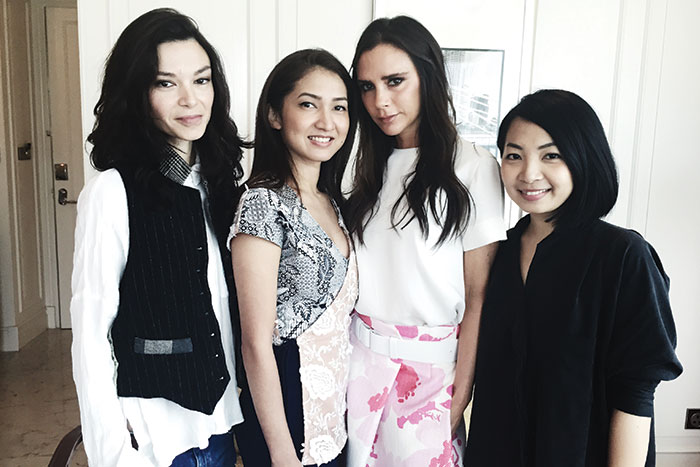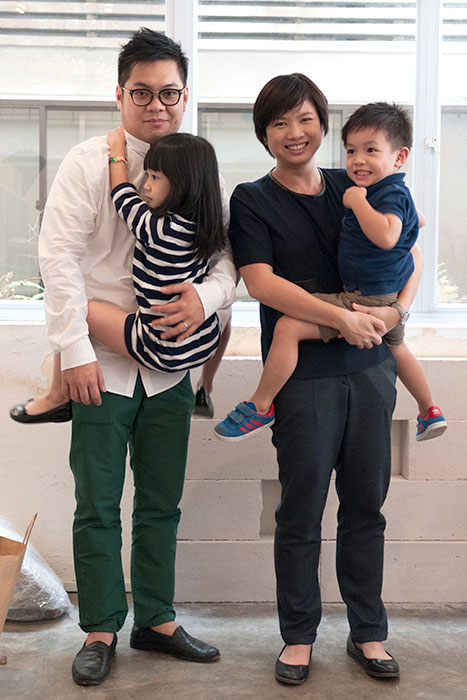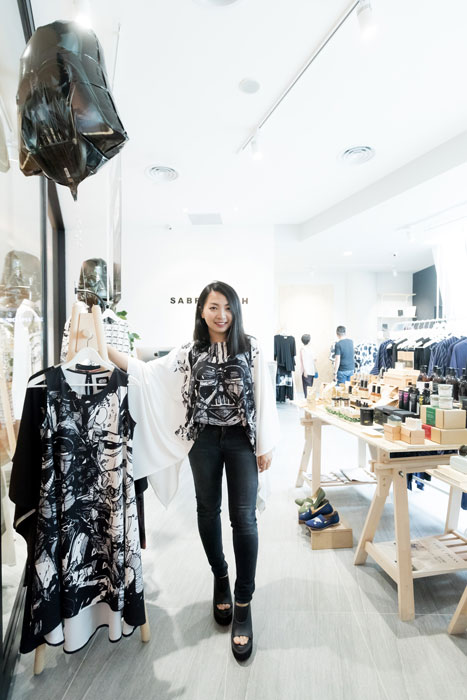The Star Wars marketing machine has been in overdrive with collaborations with Singaporean designers, including Edwin Low and Sabrina Goh, both City Harvest Church members. Each tells City News Weekly what underpins their artistry and creativity.

Customers checking out Supermama’s designer giftware at its store at the Singapore Art Museum, opened in 2014.
PHOTOS COURTESY OF SUPERMAMA
EDWIN LOW OF SUPERMAMA
It was the desire to spend more time with his children, a girl, 2, and a boy, four months then, that led 36-year-old designer Edwin Low to quit his job as a polytechnic lecturer in 2010. With a young family to support, the importance of a regular pay check could not be overstated, but Low did not want to miss out on his children’s formative years. His wife, Mei Ling, not only supported the idea but took a year’s sabbatical from her civil service job to join her husband at home.
Given his background in industrial design, Low had a keen appreciation for well-designed products and thus the couple decided to set up a shop selling giftware and souvenirs to supplement their new lifestyle. They downgraded from a four-room HDB flat and cashed out about $150,000 in combined savings to set up shop at Seah Street in March 2011.
The shop, which Low named “Supermama” on a whim in reference to his wife, started out selling imported products especially from Japan; a short-term immersion programme to Japan organised by the DesignSingapore Council several years ago had introduced him to Japanese design and craft which included woodwork and washi paper-making, and he came away impressed. “The entire country of Japan seems to have good design sense and taste,” Low says.
Without any retail background, however, they expected the business to fold within a year; revenue in the first month amounted to all of $600. Yet Low says, “Supermama was the best decision we ever made. We learned so much. The first year, I prayed with my wife in our shop every day. Barely anyone came. Even if I lost everything, I gained a year of deeper intimacy with my wife. It was amazing.”
The business hobbled along until the third year, when a serendipitious meeting with several representatives from Kihara, an established Japanese porcelain manufacturer in the town of Arita with a 400-year history in porcelain manufacturing, set in motion a collaboration that has lasted till today. The company agreed to manufacture Supermama’s first collection, the Singapore Icons series, funded with $30,000 from Low’s life insurance policy and additional support from the DesignSingapore Council. It was a bet well placed; the collection sold more than 10,000 pieces and won the President’s Design Award in 2013.
Supermama’s business gained momentum from then on, and Kihara, which had also been trying to expand, gained a new market. Today, Supermama is known as one of the go-to places to buy meaningful giftware that represents the contemporary Singapore culture. “The idea of giving is Biblical. When you give to someone, you feel happy when that person is blessed,” says Low.
“We also realised that we are filling a gap—there is a ‘material culture void’ in Singapore. We usually associate Singapore with the gardens, food, dynamic mix of cultures and so on…however, if you look at the souvenirs segment, it is sorely underdeveloped.”
Supermama prides itself on the rich narrative value of its products. “I grew up on my grandma’s pig farm and have seen how Singapore progressed from a kampung to a developed city. It would be a pity if many of our rich heritage stories were not told. As a local Singapore designer, I think it is necessary to tell the Singapore story in a very intentional way. The souvenir object should always be a starting point for conversation.”
Even Supermama’s highly anticipated Star Wars-themed porcelain plates made with Kihara and launched this month contains an element of the Singapore culture; intricate Peranakan motifs form the backdrop for its original Star Wars artwork to deliver an arresting image that is at once nostalgic and futuristic.

Starwars | The Heirloom Collection featuring Stormtrooper; other designs include Darth Vader, Death Star and Yoda.
Low believes that good design translates into longevity of not just the product but the craft itself. “I see design not just in the finished form of a product, but as a medium to expand the richness of a legacy and carry it from one generation to the next. Every brand is an extension of the founder and I am proud to say that I personally know all the makers of the products we carry. I know the people who benefit whenever I sell a piece of porcelain, I know the values underpinning their work.” In this era of mass production and global value chains, Low is constantly questioning himself. “Am I creating junk, promoting consumerism or impulse buying?”
At the same time, Low is passionate about supporting the local design scene. “I have come across a lot of outstanding works that local designers have done for international labels and markets. However, they are never quite known locally. I want Supermama to be a point where the public can be introduced to our own talented designers and design agencies through the collections we created with them.” To date, Supermama has worked with over 80 local designers.
Now that their children are older—Donna is 8 and Toby is 6—and with Mei Ling rejoining him at the gallery, Low has big plans for Supermama. He hopes to create “smart” souvenirs to enhance the Singapore tourist experience. At the same time he wants to expand beyond the souvenir market and create usable homeware for the overseas market. He also dreams of setting up shop in Tokyo one day: “Perhaps one day we can have our own Singaporean Muji?”
Supermama’s flagship store is located at 265 Beach Road. It opens from 11am to 8pm daily. For more information, go to www.supermama.sg.
People. I like to observe people when I talk to them. Every person lives in his / her own world. A good conversation gives you access to this world.
What makes Singapore culture unique to you?
I think this is the uniqueness of our culture—it is the beautiful amalgamation of borrowed cultures.
As a Christian, what are some do’s and don’ts you can share about starting a business or pursuing God’s calling for one’s life?
- There is nothing “special” about being an entrepreneur, a civil servant or a full time minister. Most importantly, know that God wires us differently and places us in different seasons for different purposes.
- Everybody needs somebody. For me it’s always this pattern: hear from God, check with wife. Every decision that I make, big or small, I will share with Mei Ling. If I sense any bit of hesitation—even if I heard or thought I heard from God, I will stop and ponder. Husband and wife must agree on everything.
- Finally, and this is a very tricky one—I don’t “sell Jesus.” I don’t work SO THAT I can reach out to others. I work because I believe what I do add value to the society this must comes first. Whatever you do, do it heartily as to Jesus, and not to man.
Good design is…
Good design impacts life directly. It is a very deliberate attempt to make things better. Design is a way of thinking—how we look at our existing human conditions and how to strive to make it better with the resources at hand.
SABRINA GOH OF ELOHIM BY SABRINA GOH

Goh (far right) with Victoria Beckham and local designers Chelsea Scott-Blackhall and Priscilla Shunmugam-Ong.
PHOTO COURTESY OF SABRINA GOH
When an email came from the Walt Disney Company to explore the possibility of working together, it felt surreal to fashion designer Sabrina Goh. Just the day before, she and her husband and colleague, Jason Fu, had been mulling over a wish-list of collaborators. Several rounds of discussion ensued between the multi billion-dollar conglomerate and the seven-year-old Singaporean start-up, before Goh launched into creative overdrive to produce two exclusive collections featuring Minnie Mouse and Star Wars.
“Minnie Mouse and Star Wars are both iconic, and also completely different,” says Goh. “It was fun working on two seemingly different spectrums of popular culture. I was a late-starter with Star Wars and watched my first Star Wars movie, The Phantom Menace in 1999 with my father, which I remember vividly because I loved Queen Amidala. I’ve since watched the entire series a couple of times.” Goh’s favorite characters from the franchise are the droids, R2D2 and C3PO. “Their ‘bromance’ is a pull for me towards the Light side. I think their selflessness and unwavering loyalty towards the humans is what adds to their charm,” she adds.
The 31-year old Goh graduated from LASALLE SIA College of the Arts in 2005 and worked with several brands before launching her fashion label Elohim by SabrinaGoh in 2009. As with all start-ups, the early years were challenging; Goh, who has been a member at City Harvest Church since 2003, credits her cell group members for always supporting her and praying with her.
In 2010, she was recognized as “Designer of the Year” at the ELLE Awards Singapore, and has gone on to showcase at the Audi Fashion Festival and Blueprint, Singapore’s premier fashion tradeshow, as well as on international platforms in cities including Bangkok, New York, Los Angeles and, most recently, Shanghai.
The business has since grown from a humble one-rack space in a multi-label store to a 870 sq ft standalone flagship store at Capitol Piazza in Singapore. Her clothes are also sold in the US, UK, Japan and China.
Last year, Goh was one of four local designers selected for the Fashion Futures 2015 X CFDA Induction program, which gave her the opportunity to be mentored by renowned international designers Diane von Furstenberg, Thakoon, Victoria Beckham, Prabal Gurung, as well as Sarah Rutson from Net-A-Porter. The interaction with the industry veterans encouraged her to continue obtaining international exposure while building a strong local base in Asia.
In achieving this, Goh leveraged multiple partnerships with both local and regional players. Indeed, 2016 has been a year of collaboration for Goh; in March, she was selected to represent Singapore at an annual fashion event commissioned by Japanese fashion brand Sakura Collection. For the showcase in Yokohama, she created a range using artisanal kimono fabric. She also designed her first ever children’s collection in collaboration with Mummyfique, a local digital platform focusing on mothers, babies and young children. These collaborations have helped the business to not just survive but grow in what has been a challenging retail market, says Goh.
For the collaboration with Disney, the “Minnie Rocks The Dots” collection juxtaposes Minnie Mouse’s iconic, polka dots with the structured, architectural style for which Goh is well-known. “It was important to me that I stayed true to my aesthetic which is minimalistic yet experimental in shape and volume,” explains the draughtsman’s daughter who counts her father’s architectural drawings as a key inspiration for her style.
Goh’s Star Wars-themed “Equilibrium” collection—named in reference to the interplay between the Light and Dark sides of the Force—merged her niche for asymmetrical cuts with Darth Vader’s signature caped silhouette to create a range of dramatic cape tops and dresses, as well as cropped sleeveless tops and wide-cut culottes in R2D2 and C3P0 composite patterns.
Needless to say, the collection has given the franchise a boost in the female market as typical Star Wars apparel has up to now been limited to fanboy tees. Goh has also relished the opportunity to reinterpret themes of good and evil through these beloved movie characters. But then, she has long been weaving timeless truths and values into her designs.
For an earlier collection, “Broken Beauty”, Goh took inspiration from kintsugi, the Japanese aesthetic art of repair, in which broken pottery is carefully restored with silver and gold lacquer by a master craftsman.
“Within brokenness, there is beauty,” says Goh. On her website is a passage from the Bible in 2 Corinthians 4:8-10, “We are hard pressed on every side, but not crushed; perplexed, but not in despair; persecuted, but not abandoned; struck down, but not destroyed.” “It’s never just about a dress. Fashion trends come and go, but the stories we tell through them are eternal,” says Goh.
The collections are available from the SABRINAGOH Flagship Store at Capitol Piazza, TANGS at Tang Plaza Level 2, Takashimaya Level 3 and online at www.sabrinagoh.com.


